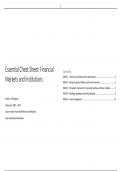Samenvatting
Summary Essential Cheat Sheet: Financial Markets and Institutions
Master Financial Markets and Institutions with the Ultimate Cheat Sheet! Get ahead in Financial Markets and Institutions with a cheat sheet designed to make studying easier and more effective. Packed with summaries of key concepts and essential formulas, this guide condenses the most important t...
[Meer zien]




